Foreign Insulators
by Marilyn Albers
Reprinted from "INSULATORS - Crown Jewels of the Wire", October 1980, page 16
A Chinese Clothespin and an Australian Gold Mine
Fellow
collectors Dolores and Wayne Dixon live in Wiesbaden, West Germany, but were able
to spend their vacation time in China. I was delighted to receive the following
letter recently from Dolores and would like to share it with you.
20 May, 1980
Dear Marilyn,
A quick note to let you know that we returned from China with an
insulator for you which will be mailed by a friend of ours in the States. There
are no markings and it is brand new because insulators in China are used for
everything from stringing wires to hanging clothes. They are evidently mass
produced very cheaply as we found them in a tiny shop in the old section of
Chengtu. Since they are used so widely and evidently must be purchased, there
were none lying around under poles, and believe me, we saw thousands of poles!
Our guides knew nothing about them and we felt they considered us to be quite
strange when there were so many other things that could be purchased. All that
we saw were already cemented on the pin so that's the way we had to take them.
We did see a few on poles (usually in the middle of a rice paddy) that were
slightly larger and different but could find none of those for sale. Antiquing
and flea marketing did no good either as is the case in Europe. It is a
non-marketable item here.
The trip itself was fantastic and we would recommend
it to all. We were taken into the interior (Cheng-tu) and from there taken off
to one of their sacred mountains where 15 of us were the only Westerners there.
It was a great feeling. Hope you like the little insulator and sorry there are
no markings.
Sincerely,
Dolores
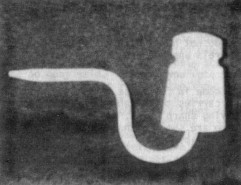
- - - - - - - - -
Needless to say, this started me looking for the
mailman (Show me an insulator collector who doesn't!) It wasn't long before the
package arrived with the insulator. It's a cute little thing -- it's white and it
measure only 3" high and 2" across the base. The picture at left shows
it still cemented to the metal pin, and I intend to leave it that way. You see?
Santa Claus does come more than once a year! My husband is always reminding me
he doesn't. Thanks, Wayne and Dolores, for a very welcome addition to my
collection.
About a week later another country was heard from. Robert
Chiantelli, of Monterey, California, had been visiting his sister in Alice
Springs, Australia, and found what you and I would kill for -- miles and miles of
poles full of insulators with no wires on them. He wrote, "They are of no
interest to anyone except the birds that sit on them,"
I have three
letters from Robert here in front of me and will attempt to condense into one
tale all that he said. With each new find he became more enthusiastic and wrote
another letter. My eyes are as big as saucers at this point. "The first day
out," he said, "I found 29 of them in less than 1/4 of a mile and in
less than 1 hour of looking."
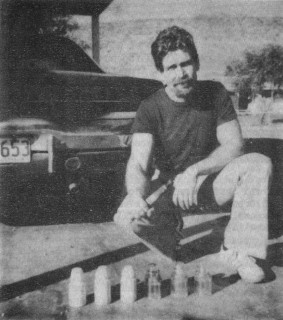
I don't know how well this colored polaroid
picture will reproduce after being further digested by Crown Jewels, but perhaps
you will at least be able to see Robert in the picture! He is kneeling beside
six insulators he found, three glass CD 130.7 in clear, straw and pinkish amber,
and three white porcelains similar to the CD 130.7 in shape. Robert does not say
what markings are on the glass ones, but probably they are either C.C.G. (Crown
Crystal Glass) or A.G.M. (Australian Glass Manufacturers). The porcelain have
underglaze ink markings stamped on the crown top or side and read KP 59, FB 40
and R.F. LTD. 1944 Ex. The letters stand for company names, and the numbers
indicate the date of manufacture. All six insulators came from a telephone line.
Other glass insulators he saw still on the poles were CD 130.7 in blue (!), CD
152.9 in purple, CD 124.7 in "various colors", CD 121 and CD 121.2 in
purple, green, and purple-cobalt blue. "It is possible," he says,
"that there are some shaped like this, but I did not have the time to stop.
The color was purple. I do not know the CD of this style, but it looked somewhat
like a castle." (This is Robert's own sketch.)

He goes on to say, "If
someone wanted all that were along about a mile of highway he could get about
600 insulators for about 4 hours of work. One pole alone had 98 insulators on
it. Please pass it on to the readers of Crown Jewels and other collectors that
they are just there for the picking up."
In a letter to Jack Tod (that Jack
sent on to me) Robert wrote, "I was also lucky enough to find a stretch of
the original Overland Telegraph Line from Adelaide to Darwin and found some of
the original insulators still on the old poles. This old telegraph line was
completed in 1872. I found out through asking that they were indeed that old. I
must have 18-20 that are different in color, shape and embossing." Robert
shows a few of these insulators in the picture on the following page.
As a final
note he adds, "the colors of porcelains that I have found or have seen
varies: from blue (Japanese manufacture?), white and brown to fire engine red.
The red ones I saw in Sidney by the airport.
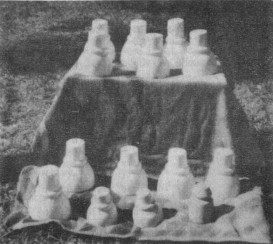
A few of Robert Chiantelli's
old white
porcelain insulators from the original Overland
Telegraph Line from
Adelaide to Darwin.
Robert will be at the Bakersfield Show to be held October 11
and 12 and will have a suitcase or two full of traders. Now that I've told you
this, I just hope I can run faster than you can! And if anyone calls for me
after the Bakersfield Show, I've gone to Australia!!
For those of you (please)
who would like to make shadow drawings of your foreign insulators and send them
to me for "Le File", I have included the following. I hope it will be
of help to you. It is Jack Tod's method for making the drawings and for
recording the markings found on insulators. However, any pictures or other
information will be most welcome.
RECORDING INFORMATION ON INSULATORS
Very good
drawings of insulators can be sent through the mail with the use of a
"shadow profile" and carefully measured dimensions as follows:
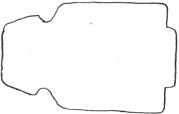
Figure
A. SHADOW PROFILE
Place the insulator over a sheet of paper on the floor
directly below a ceiling light fixture. Plumb the true vertical with a length of
string. Unscrew all but one bulb in the fixture to eliminate multiple shadows.
Prop up the top of the insulator so its axis will remain parallel with the floor
without having to hold it.
Now get down on your tummy and carefully trace onto
the paper the shadow cast by the insulator. This should look like Figure A at
left. Don't tweek up the lines on this profile or add any other detail to it
(dimensions, hidden lines, etc.).
Now make a separate sketch of the insulator as
shown in Figure B on the following page. Sketch onto it the hidden lines not
shown by the profile. Carefully measure the dimensions needed for us to complete
the drawing, and add these to the Figure B sketch as shown. Also measure the
overall insulator height, the overall base diameter, and the diameter at some
indicated point near the insulator crown. (The accompanying drawings are reduced
in size to fit this instruction sheet.)
If the insulator has a saddle top or
other details which don't show up in the shadow profile, try to sketch those
details on a separate sketch to show what they look like. Some oddball
insulators with protruding pieces may also require an additional shadow profile
looking down from the top or a shadow profile viewing the insulator rotated 1/4-turn on its axis.
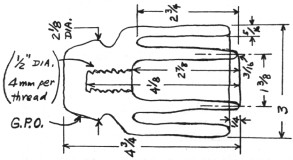
Figure B. SKETCH FOR DIMENSIONS
Lacking calipers, outside diameters can be measured by
placing the insulator between two stacks of books and then measuring that
distance. The depths of pinhole and recesses between petticoats can be measured
by using a narrow strip of cardboard and then measuring its penetration. Measure
or estimate the pinhole diameter (the minor thread diameter near the threads
collar)
Thread pitch (threads per inch) is
helpful in attributing foreign insulators, since a given country usually uses
one thread size throughout. England and related countries use English-unit
threads (threads per inch). Most other European countries use metric threads
(millimeters per thread). You can determine the exact thread type and its pitch
as follows:
Smooth a small piece of new kitchen foil by rubbing it with your
finger on a flat surface. For large pinholes, cut a 1/2" foil strip and
insert it into pinhole. Press foil against thread with your finger. For small,
deep pinholes, insert a 1/4" foil strip and then on top of that a 1/4"
strip of innertube or other rubber (tweezers help here). Insert a round pencil
on top of the rubber and press hard on the rubber while rolling the pencil and
slightly rocking it back and forth.
Measure from the foil the threads per inch
(or twice the number per 1/2") If that doesn't come out to a whole number,
measure thread-to-thread in millimeters (or for 3 threads and divide by 3). If
metric threads, this should come out a whole number.
Copy all the insulator
markings as best you can, and indicate location of markings on the insulator. On
porcelains, indicate type of marking: incuse, underglaze ink, or sandblast. Good
foil impressions of incuse markings can be made by repeatedly pressing smoothed
foil hard with a rubber eraser. Dry a puddle of glue on the back for mailing.
| 